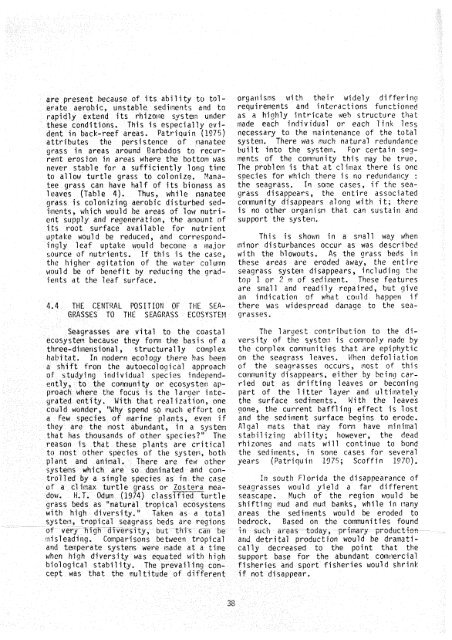The Ecology of the Seagrasses of South Florida - USGS National ...
The Ecology of the Seagrasses of South Florida - USGS National ...
The Ecology of the Seagrasses of South Florida - USGS National ...
Create successful ePaper yourself
Turn your PDF publications into a flip-book with our unique Google optimized e-Paper software.
are present hecause <strong>of</strong> its abi l i ty to to1 -<br />
erate aerobic, unstablc sedirqents and to<br />
rapldfy extend its rhizorse systen under<br />
<strong>the</strong>se conditions. This is especially cvident<br />
in back-reef areas, Patriquin (19753<br />
attributes <strong>the</strong> persistence OF nana tcc<br />
grass in areas around Barbados to recurrent<br />
erosion in areas where <strong>the</strong> hottom was<br />
never stable for a sufficiently long tine<br />
to allow turtle grass to colonize. Manatee<br />
grass can have half <strong>of</strong> its biomass as<br />
leaves (Table 4). Thus, while manatee<br />
grass is col onizing aerobic disturbed sedinrents,<br />
vihlch would he areas <strong>of</strong> low nutricr'lt<br />
supply and regeneration, <strong>the</strong> arqount <strong>of</strong><br />
its root surface available f ~ nutrient r<br />
0pt.a ke woul d he reclucetl , and correspatldingly<br />
ltldfp uptakc would become a major<br />
source <strong>of</strong> nutrients, If this is <strong>the</strong> case,<br />
thc higher agitdtfon <strong>of</strong> <strong>the</strong> wdter column<br />
would be <strong>of</strong> benefit l-ty reducl'ng <strong>the</strong> gradients<br />
at <strong>the</strong> leaf surfacc.<br />
4.4 THE CENTQAL POSITION OF THE SEA-<br />
GRASSES TO TMt SEAGRASS ECOSYSTEM<br />
orgaili sirrs t~i th <strong>the</strong>ir widely di fferincr<br />
requirements and interactions functioned<br />
as a hi9hly intricate v~eh structure that<br />
made each individual or each link less<br />
necessary to <strong>the</strong> maintenance <strong>of</strong> <strong>the</strong> total<br />
system. <strong>The</strong>re was mttch natural redundance<br />
bull t into <strong>the</strong> system. For certain segr~ents<br />
<strong>of</strong> <strong>the</strong> co~qrjunity this may be true.<br />
<strong>The</strong> problem is that at cl irnax <strong>the</strong>re is one<br />
species for vrhich <strong>the</strong>re is no redundaricy :<br />
<strong>the</strong> seagrass. I0 some cases, if <strong>the</strong> seagrass<br />
disappears, <strong>the</strong> entire associated<br />
co~muni ty disappears along with it; <strong>the</strong>re<br />
is no o<strong>the</strong>r orgavlisri that can sustain arid<br />
support <strong>the</strong> systen.<br />
This is shown in a sr~all way when<br />
mi nor di s turbanees occur as was described<br />
v ~ th i <strong>the</strong> hlowouts. As <strong>the</strong> yass beds in<br />
<strong>the</strong>se areas are eroded away, <strong>the</strong> entire<br />
seaqrass systcrn disappears, including <strong>the</strong><br />
top 1 or 2 $4 <strong>of</strong> sediinent. <strong>The</strong>se features<br />
are siilall and readily repaired, hut give<br />
an indication uf whdt cotild happen if<br />
<strong>the</strong>re was widespread danage to <strong>the</strong> scagrasses.<br />
<strong>Seagrasses</strong> are vital to <strong>the</strong> coastal <strong>The</strong> largest cnntribut.ion to <strong>the</strong> diccosyste~i<br />
because <strong>the</strong>y fann <strong>the</strong> &sf'; <strong>of</strong> a versity <strong>of</strong> <strong>the</strong> systt?~: is cornr~only nade by<br />
three-dirilertsionali , structural ly complex <strong>the</strong> conpl ex cominrnni ties that are epiphytic<br />
halri tat, In inodern ecology <strong>the</strong>re has heen on tho scaqrass leave?. defol iation<br />
a shfft Frorn <strong>the</strong> autwecolo~~ica'l, approach <strong>of</strong> <strong>the</strong> seagrasses occurs, most <strong>of</strong> this<br />
<strong>of</strong> studylng irrdividual specics ir~dcpcnd- cctnl~runity disappears, ei<strong>the</strong>r by being care?t~tly,<br />
to <strong>the</strong> corl~iuni ty or ecosystci:~ ap- ried out as drifting leaves or becoming<br />
groach where <strong>the</strong> focus is <strong>the</strong> l argsr i rite- part <strong>of</strong> <strong>the</strong> 1 i tter 1 ayer and ul tirnit tel y<br />
yvcrted cnti ty. Uith that real ization, one <strong>the</strong> surface sediments. Rith <strong>the</strong> leaves<br />
caul$ wonder, "Why spend s8 riuch effort on gone, <strong>the</strong> current baffling effect is lost<br />
a Few ~peciefi <strong>of</strong>' rnarine plants, evctlr if and <strong>the</strong>! sedirnent surface hegins to erode.<br />
tiley are <strong>the</strong> most abundant, in a system A1;:al nats that nay fom have minimal<br />
that hds thousands <strong>of</strong> o<strong>the</strong>r species?'<strong>The</strong> stabilizing abi 1 ity; however, <strong>the</strong> dead<br />
rrrinsan is that <strong>the</strong>se pldnts are critical rhizonws and [%its will continue to bond<br />
ta crast o<strong>the</strong>r species nf <strong>the</strong> system, both <strong>the</strong> sedirnerlts, it1 some cases for several<br />
plant and animal. <strong>The</strong>re are Feu o<strong>the</strong>r years (Patriqtdin 1375; Sc<strong>of</strong>fin 1970).<br />
systerqs which dre so doiqinated and controlled<br />
by a single species as in <strong>the</strong> case<br />
In south <strong>Florida</strong> <strong>the</strong> disappearance <strong>of</strong><br />
<strong>of</strong> a cl inax turtle grass or Tostera mca- seagrasses would yield a far different<br />
dow. H.T, Odurrl (1974) class~?~~-~urtle seascape. ?!uch <strong>of</strong> <strong>the</strong> region would be<br />
grass beds as '"natural tropical ecosystens shifting mud and mud banks, while in [?any<br />
with high diversity.'Vaken as a total areas <strong>the</strong> sediments would be eroded to<br />
r;ystc~*r, tropical seayrass beds are regions bedrock. Based on <strong>the</strong> communities found<br />
<strong>of</strong> very hTgR aiversity, brit this cdn be fri such ariras tod?ry, primary prodttctiet:<br />
c:?isleaditrg. Conparisans betueen tropical and detri tal product ion would be dramatiand<br />
ternperate systems were made at a time cally decreased to <strong>the</strong> point that <strong>the</strong><br />
when hl'gh diversity was equated with high support base for <strong>the</strong> abundant co~nr~ercial<br />
biological stability. <strong>The</strong> prevail iny can- fisheries and sport fisheries would shrink<br />
cept was that <strong>the</strong> multitude <strong>of</strong> different if not disappear.<br />
38

















